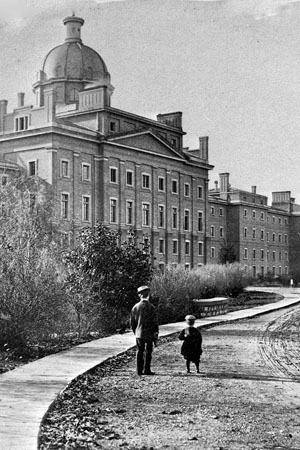Browse "Science & Technology"
-
Article
Mental Health
In the early years of the mental-health movement, mental health was often defined as the absence of symptoms of mental illness. Since that time, attempts have been made to relate mental health to a concept of psychological well-being and to certain capacities of individuals, eg, the capacity to perceive reality "objectively," to be flexible in meeting new situations and to understand another's point of view. However, no clear line divides the mentally healthy from the mentally unhealthy, and in addition, the definition of mental health is relative and is dependent on cultural context. The characteristics of a mentally healthy person in one milieu may seem very different from those of a mentally healthy person in another.
"https://d2ttikhf7xbzbs.cloudfront.net/media/media/ecca8dc5-763b-46ab-b80f-133c8b6a7e03.jpg" // resources/views/front/categories/view.blade.php
https://d2ttikhf7xbzbs.cloudfront.net/media/media/ecca8dc5-763b-46ab-b80f-133c8b6a7e03.jpg
-
Article
Metallurgy
Metallurgy is the art, science and technology of turning metals and alloys (i.e., materials consisting of two or more metals) into forms suitable for practical use.
"https://d2ttikhf7xbzbs.cloudfront.net/media/media/3ed8d545-4edb-40bb-bc0e-6d7b68d6c22a.jpg" // resources/views/front/categories/view.blade.php
https://d2ttikhf7xbzbs.cloudfront.net/media/media/3ed8d545-4edb-40bb-bc0e-6d7b68d6c22a.jpg
-
Article
Metamorphic Rock
Metamorphic rock is one of the 3 major classes of rock comprising the Earth's crust, the others being SEDIMENTARY and IGNEOUS ROCKS. Metamorphic rock has been transformed, while in the solid state, by pressure, temperature and deformation.
"https://d2ttikhf7xbzbs.cloudfront.net/media/media/e0a546d9-bcaf-41e5-a7d4-076b178b5592.jpg" // resources/views/front/categories/view.blade.php
https://d2ttikhf7xbzbs.cloudfront.net/media/media/e0a546d9-bcaf-41e5-a7d4-076b178b5592.jpg
-
Article
Meteorology
Physical meteorology links meteorology and physics in studies of 3 core topics: electromagnetic radiation, meteorological thermodynamics and cloud physics. Related topics include stratospheric physics, atmospheric electricity, optics and ACOUSTICS.
"https://development.thecanadianencyclopedia.ca/images/tce_placeholder.jpg?v=e9dca980c9bdb3aa11e832e7ea94f5d9" // resources/views/front/categories/view.blade.php
https://development.thecanadianencyclopedia.ca/images/tce_placeholder.jpg?v=e9dca980c9bdb3aa11e832e7ea94f5d9
-
Article
Metric Conversion
Metric conversion was the process of making metric units — such as metre, kilogram and degree Celsius — the common units of measurement in Canada, leaving the British imperial system (with units such as yard, gallon and pound) behind. The process was fraught with political interference and public resistance, and took place incrementally between 1970 and the early 1980s. Despite the shift, many Canadians still express certain measurements in imperial units, such as height (feet and inches).
"https://development.thecanadianencyclopedia.ca/images/tce_placeholder.jpg?v=e9dca980c9bdb3aa11e832e7ea94f5d9" // resources/views/front/categories/view.blade.php
https://development.thecanadianencyclopedia.ca/images/tce_placeholder.jpg?v=e9dca980c9bdb3aa11e832e7ea94f5d9
-
Article
Metropolitan-Hinterland Thesis
The Metropolitan-Hinterland Thesis is a theory of historic relations between a large, powerful urban community (metropolis) and the surrounding territory (hinterland) which the metropolis dominates through mainly economic means. Formulated by economic historian N.S.B.
"https://development.thecanadianencyclopedia.ca/images/tce_placeholder.jpg?v=e9dca980c9bdb3aa11e832e7ea94f5d9" // resources/views/front/categories/view.blade.php
https://development.thecanadianencyclopedia.ca/images/tce_placeholder.jpg?v=e9dca980c9bdb3aa11e832e7ea94f5d9
-
Macleans
Mice Cloned
It was a humble setting for an epochal scientific breakthrough - a nondescript two-storey building tucked away on the sprawling University of Hawaii campus overlooking Honolulu's Waikiki district.This article was originally published in Maclean's Magazine on August 3, 1998
"https://development.thecanadianencyclopedia.ca/images/tce_placeholder.jpg?v=e9dca980c9bdb3aa11e832e7ea94f5d9" // resources/views/front/categories/view.blade.php
https://development.thecanadianencyclopedia.ca/images/tce_placeholder.jpg?v=e9dca980c9bdb3aa11e832e7ea94f5d9
-
"https://development.thecanadianencyclopedia.ca/images/tce_placeholder.jpg?v=e9dca980c9bdb3aa11e832e7ea94f5d9" // resources/views/front/categories/view.blade.php
https://development.thecanadianencyclopedia.ca/images/tce_placeholder.jpg?v=e9dca980c9bdb3aa11e832e7ea94f5d9
-
Article
Miguasha Fossils
In addition to fishes, a few INVERTEBRATES, such as small CRUSTACEANS, worms and eurypterids, which are giant cousins of land scorpions, lived at the bottom of the estuary.
"https://development.thecanadianencyclopedia.ca/images/tce_placeholder.jpg?v=e9dca980c9bdb3aa11e832e7ea94f5d9" // resources/views/front/categories/view.blade.php
https://development.thecanadianencyclopedia.ca/images/tce_placeholder.jpg?v=e9dca980c9bdb3aa11e832e7ea94f5d9
-
Article
Military Aviation
Military aviation began with the use of balloons for observation as early as 1794, during the French Revolution.
"https://d2ttikhf7xbzbs.cloudfront.net/media/media/6d7d5d34-f0d2-4f3b-9f9b-997d3b6ec7a8.jpg" // resources/views/front/categories/view.blade.php
https://d2ttikhf7xbzbs.cloudfront.net/media/media/6d7d5d34-f0d2-4f3b-9f9b-997d3b6ec7a8.jpg
-
Article
Military Engineers
Military engineers are soldiers specially trained to apply engineering science and technology to war. Their designation as "sappers" refers to their task of sapping - digging trenches.
"https://development.thecanadianencyclopedia.ca/images/tce_placeholder.jpg?v=e9dca980c9bdb3aa11e832e7ea94f5d9" // resources/views/front/categories/view.blade.php
https://development.thecanadianencyclopedia.ca/images/tce_placeholder.jpg?v=e9dca980c9bdb3aa11e832e7ea94f5d9
-
Macleans
Military to Investigate Illnesses
Everybody agrees it was a dirty job. When Canadian Peacekeepers arrived in Croatia in 1993, many had to work near abandoned industrial sites destroyed during the war that had torn apart the old Yugoslavia. Some got covered in reddish grit while filling sandbags.This article was originally published in Maclean's Magazine on August 9, 1999
"https://development.thecanadianencyclopedia.ca/images/tce_placeholder.jpg?v=e9dca980c9bdb3aa11e832e7ea94f5d9" // resources/views/front/categories/view.blade.php
https://development.thecanadianencyclopedia.ca/images/tce_placeholder.jpg?v=e9dca980c9bdb3aa11e832e7ea94f5d9
-
Macleans
Millennium Preparations
Maj. Rod Babiuk picked up his brass abacus for a buck at a garage sale, while many of his colleagues at CFB Kingston hunted down wooden versions of the beaded counting machines. No, the army has not developed a sudden interest in ancient math.This article was originally published in Maclean's Magazine on December 20, 1999
"https://development.thecanadianencyclopedia.ca/images/tce_placeholder.jpg?v=e9dca980c9bdb3aa11e832e7ea94f5d9" // resources/views/front/categories/view.blade.php
https://development.thecanadianencyclopedia.ca/images/tce_placeholder.jpg?v=e9dca980c9bdb3aa11e832e7ea94f5d9
-
Article
Mineral
A mineral is an element or chemical compound formed in nature, usually by inorganic processes. Minerals may be composed of one element such as carbon (DIAMOND) or GOLD, or of several elements.
"https://d2ttikhf7xbzbs.cloudfront.net/media/media/c877e97e-4b7c-48c5-b937-a17b8f6fde9b.jpg" // resources/views/front/categories/view.blade.php
https://d2ttikhf7xbzbs.cloudfront.net/media/media/c877e97e-4b7c-48c5-b937-a17b8f6fde9b.jpg
-
Article
Mineral and Mining Engineering
Mineral engineering is that branch of ENGINEERING concerned with the application of scientific and technical knowledge to the search for and production of valuable MINERALS from naturally occurring surface, underground or below-water deposits.
"https://development.thecanadianencyclopedia.ca/images/tce_placeholder.jpg?v=e9dca980c9bdb3aa11e832e7ea94f5d9" // resources/views/front/categories/view.blade.php
https://development.thecanadianencyclopedia.ca/images/tce_placeholder.jpg?v=e9dca980c9bdb3aa11e832e7ea94f5d9
